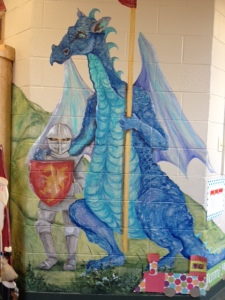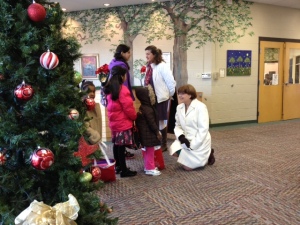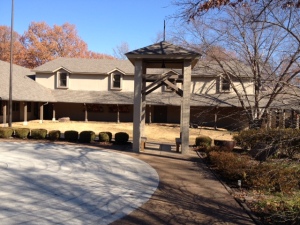 I tend to report along a timeline, at least when sorting out many pages of notes from a long days’ visit. Throw that out the window today. The story of this school wraps back on itself in several unique and powerful ways, all of which give me a greater sense of optimism for education in America than when I woke up this morning. So I am just going to dive in and swim through some history of St. George’s School, and then get to their unique commitment to the Memphis community, their rapid growth in size and footprint, great progressive programs, and some student quotes that, once again beg the question of why the adults don’t plan for the future by listening to the kids. Read on!
I tend to report along a timeline, at least when sorting out many pages of notes from a long days’ visit. Throw that out the window today. The story of this school wraps back on itself in several unique and powerful ways, all of which give me a greater sense of optimism for education in America than when I woke up this morning. So I am just going to dive in and swim through some history of St. George’s School, and then get to their unique commitment to the Memphis community, their rapid growth in size and footprint, great progressive programs, and some student quotes that, once again beg the question of why the adults don’t plan for the future by listening to the kids. Read on!
I am not going to go into details of the history of the school because I would get them twisted, but here is a summary. The school used to be an elementary only in the relatively well-off Memphis suburb of Germantown. Due to their success, there was pressure from parents to add a middle school, and even a high school. Through a number of rather turgid turns, fortuitous grants from generous donors, and an unfortunate rift with the Episcopal Church, they went through a rapid expansion to what is now a highly unique three-campus configuration. The original elementary school still operates in Germantown with about 450 students. About 12 years ago they bought and expanded an elementary school in a highly underserved section of Memphis as an intentional attempt to model how an independent school could make a real commitment to community transformation. The Memphis campus has about 150 students. They also received a donation of land in the eastern Memphis suburb of Collierville and opened a middle and upper school campus that has rapidly grown to about 700 students.
The two elementary schools offer virtually the same program, one to a largely white, relatively affluent community with narrow geographic diversity, the other to a largely African American population of families who come from more than 30 zip codes. The average financial assistance for the families at the Memphis campus is 90% and more than 50% receive free or reduced breakfast and lunches. Overall, the school went from one elementary school with 360 students to two elementary campuses and the middle/upper school campus with a total of 1,200 students in five years.
 Almost all of the students from both the elementary schools go on to middle school at St. George’s. As the Memphis campus students fill out the high school (the first class from Memphis is now in 9th grade), the school will have about 30% students of color, which is way over the norm for Memphis area independent schools. Financial aid is provided by a combination of the original donor endowment, ongoing philanthropy, and a minor contribution from tuition. All told, St. George’s commits about 18% of their revenue to financial assistance, which is well above national or regional averages. In summary, the St. George’s community, supported by some generous philanthropy from the greater Memphis community, is making a real and sustained commitment to providing an exceptionally-high quality education to underserved families, and at the same time providing critical racial and socio-economic diversity in what would otherwise be a largely homogenous Caucasian school.
Almost all of the students from both the elementary schools go on to middle school at St. George’s. As the Memphis campus students fill out the high school (the first class from Memphis is now in 9th grade), the school will have about 30% students of color, which is way over the norm for Memphis area independent schools. Financial aid is provided by a combination of the original donor endowment, ongoing philanthropy, and a minor contribution from tuition. All told, St. George’s commits about 18% of their revenue to financial assistance, which is well above national or regional averages. In summary, the St. George’s community, supported by some generous philanthropy from the greater Memphis community, is making a real and sustained commitment to providing an exceptionally-high quality education to underserved families, and at the same time providing critical racial and socio-economic diversity in what would otherwise be a largely homogenous Caucasian school.
Needless to say, many in this community are watching the model to see what happens, and from what I could find out today, the hard work, risk, and commitment is paying off. There is a long waiting list to get in to the Memphis campus and some families drive long distances to attend. When the Memphis campus opened, the two elementary campuses had different programs; those differences have narrowed over the years as the school has learned and adapted. Now the two programs are “about 90% the same” according to President Bill Taylor. As both elementary populations move on to the middle school there is still some gap in academic achievement due to levels of support at home, but the gap narrows rapidly through middle school. Bill and Middle School Head Genevieve Hoppe thinks it will disappear altogether in a matter of a few years. Bill showed me data about how well the Memphis campus students are doing on standardized tests relative to public and charter school student from the same zip codes. None of that means the process and progress are easy. Bill: “We staked our claim that through scholarship we could make a highly relevant commitment to the inner city. Unless we can make that commitment sustainable, our mission is threatened. We are providing a very different environment to many of these families. The commitment to education is percolating through the families via their students. We have had parents of our students go back to school themselves. This school is part of the mosaic of what is possible in Memphis.” They are gearing up for additional capital fund raising to ensure that they succeed.
Rapid expansion and a significant change in mission had real bumps in the road. They lost some families that did not agree with the vision of diversity, but they have gained a lot more than they lost. Bill has gone through a tremendous consolidation and organizational restructuring in his 12 years as President. Three years ago he had 25 direct reports; a year from now he will have closer to seven. The school works extremely hard to bring faculty together from the three campuses to collaborate on program development, particularly the teachers from the two elementary schools. Those teachers may only meet face to face every few weeks, but they are calling, skyping, and emailing all the time. They have embraced all-school PLC’s, in which half the faculty have volunteered to participate.
 As we toured both elementary school campuses I found that St. George’s has a long historical foundation in relatively progressive education at the lower grade levels, and the expansion across grades and up to the middle and upper schools was really a process of extending a very student-centered, highly collaborative, creative DNA to those new classes. Teachers have always designed most of their own curriculum and they had gone away from many textbooks years ago. They find that teachers who design curriculum are much more enthusiastic about teaching it, and that enthusiasm translates to the students.
As we toured both elementary school campuses I found that St. George’s has a long historical foundation in relatively progressive education at the lower grade levels, and the expansion across grades and up to the middle and upper schools was really a process of extending a very student-centered, highly collaborative, creative DNA to those new classes. Teachers have always designed most of their own curriculum and they had gone away from many textbooks years ago. They find that teachers who design curriculum are much more enthusiastic about teaching it, and that enthusiasm translates to the students.
Some specific notes about the elementary and early childhood programs:
- We watched a marvelous 2nd grade class engage in visual thinking strategies, interpreting a piece of artwork. The mindset skills I saw the teacher tease out of the class in just a few minutes: inference, perspective, thought process, time and space, reasoning, and description.
- In the 5th grade Citizenship Council (which is a precursor to additional focus on citizenship at the middle and upper schools) students choose roles in which they serve the rest of the school around campus. They take sole responsibility for activities like recycling, reading to the younger students, and organizing school events; little is controlled by the faculty.
- Students in grades 1-5 create annual plans for personal, academic, and social growth which are reviewed and updated with their teachers several times each year. By 5th grade the students are leading their parent-teacher conferences.
- Faculty engage in direct discussions with students, starting at the youngest ages, about the concepts of risk and failure. They encourage students to take risks, teaching that perfect work is an indicator that maybe the student is not reaching far enough. The faculty have started to more intentionally include parents in these lessons about risk and failure.
- They have created a buddy system between grade levels and created a series of events that make it very relevant to the students. They teach skills in listening and collaboration amongst groups of diverse ages, which also provide extensive leadership opportunities.
 Bill took me out to the Collierville middle and upper school campus. The buildings have a unique architecture that looks more like a lodge than a school, backed up on forest and wetlands of the Wolf River. Here are some of the major projects underway; and then I will finish with the student comments from lunch:
Bill took me out to the Collierville middle and upper school campus. The buildings have a unique architecture that looks more like a lodge than a school, backed up on forest and wetlands of the Wolf River. Here are some of the major projects underway; and then I will finish with the student comments from lunch:
- Upper School prefects are selected from amongst senior applicants by student vote. They are responsible for various departments and areas of student life and report directly to Bill who meets with them each week. They provide an active and direct conduit for student input and feedback on the academic and co-curricular elements of the school.
- The Upper School Honor Council, voted by their peers, has responsibility for dealing with honor code violators, meeting formally with students, working with them to develop plans to rectify or avoid further problems, and make recommendations to the administration for punishment. Students who apply for the Council go through a unique validation process: they are handed an “ethical dilemma”, given 15 minutes to think about it, and then make a public response to the students, who then vote for Council membership.
- Middle School teachers are rapidly flipping their classes. The goal this year was that each teacher would flip at least one unit; most have far exceeded that (they are mostly using Moodle).
- They have an all-school Ethical Literacy Team (another structure your school probably does not have) that trains teachers in the use of a common vocabulary and methods for teaching ethics across all grade levels. The goal is to infuse ethics into all courses and co-curricular programs. The Team presents to faculty several times a year, documents examples of ethics teaching, collects data, and has mapped an all-school scope and sequence of ethical literacy.
- The Upper School Great Outdoors program was developed based on a recognized need for students to learn about the environment and outdoors via experience, as a counterweight to the growing screen-tied student lifestyle. It has grown to more than 50 students each year going on trips like rafting the San Juan River, hiking in the Big Bend of Texas, and dogsledding and winter camping in Maine.
- The Citizenship Institute was initially funded by an EE Ford grant. Students apply in 10th grade, and go through a course of study in 11th grade that includes issues of local, national, global, and environmental consequence. The class has made trips to the Carter Center in Atlanta and to New York City to visit the Federal Reserve and the United Nations. In their senior year, participants design, develop, and produce a project that tends to have a component of action in the community. They also collaborate as a group in a project on entrepreneurial citizenship, mentored by local business people.
It was a real pleasure to spend time with a group of Upper School students over lunch (thanks ladies and gentlemen for sharing with me!). Here are some of their responses to my questions regarding what engages them in their learning:
- “Teenagers will respond to what adults tell them if they think the adult cares.”
- “In the past, teachers were defined within the four walls of the classroom. Now there are more external influences and personal connections that define the student-teacher relationship.”
- “You have to take your education into your own hands. Class periods should be for discussion.”
- “Knowledge is transferred via direct conversation between students, and between students and teachers.”
- “Technology is really the access point to so much knowledge now.”
- “Since we have to be accountable for our own learning, presentations are a key part of what we need to do.”
- “Now students do more to teach each other and the teachers are more facilitators.”
- “Everyone has their own way of learning and you have to figure out what that is and own the process.”
- “It is important to teach content, but do it through cause, effect, application, and development of themes. We remember the content much better that way.”
- “Good teachers really want us to succeed. It is about us, not them.”
I asked the students what makes a class one that they really look forward to:
- “Doing projects, like when we teach the kids at the Lower School.”
- “When we discuss something deeply and look at the different viewpoints and opinions in the world around us.”
- “Not textbook driven. It is only relevant if I can make the connection to my life.”
- “Choosing my own topic.”
- “Small class interactions.”
- “When I can talk with my teacher and other students about applications, not just the content.”
I truly enjoyed St. George’s on a number of fronts. They are making a courageous commitment to community relevance, and it is working. They have grown rapidly in a short period of time and managed the growth well. And they have an academic and social program that any school could learn from.





[…] Commitment to Diversity Leads Progressive Vision at St. George’s School, Memphis, November 29, 2012 […]